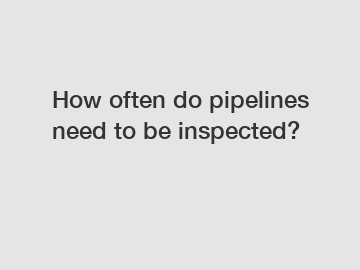Dec. 15, 2023
Energy
Pipelines play a crucial role in transporting various materials, such as oil, gas, water, and chemicals, across vast distances. From the ground beneath our feet to under the oceans, pipelines form the lifeline of our modern infrastructure. However, ensuring their safety and preventing potential leaks, corrosion, or other damages require diligent inspections. The question arises: How often should pipelines be inspected? In this blog, we dive into this important topic to shed light on the best practices and guidelines in pipeline inspection.
1. Regulatory Frameworks and Compliance.
Ensuring the safety of pipelines requires adherence to regulatory frameworks established by governmental agencies and industry standards. These regulations aim to mitigate risks associated with leaks, spills, and potential harm to the environment or humans. The frequency of inspections often depends on the pipeline's location, the substances transported, and regulatory requirements specific to different regions. Compliance with these regulations is crucial to maintain the trust and safety of both pipeline operators and the communities they serve.

2. Determining Inspection Frequency.
While regulatory guidelines provide a baseline, pipeline operators often conduct risk assessments and inspections more frequently than required to minimize potential risks and maintain the integrity of their infrastructure. Several factors influence the determination of inspection frequency:
a. Pipeline Age: Older pipelines are generally subject to more frequent inspections due to potential corrosion, material degradation, and wear and tear resulting from long-term use.
b. Pipeline Material and Coatings: Different pipeline materials may require varying inspection frequencies. For instance, pipelines made from corrosion-resistant materials may necessitate inspections less frequently than those constructed from traditional materials.
c. Geographic and Environmental Considerations: Pipelines traversing environmentally sensitive areas, such as near water bodies, highly populated regions, or earthquake-prone zones, may require more frequent inspections to minimize potential harm in case of failures.
d. Substance Transported: The type of substance transported through the pipelines can also determine inspection frequency. Hazardous materials demand more stringent inspection schedules to prevent catastrophic incidents and protect ecosystems.
e. Operational Conditions: Pipelines experiencing demanding operational conditions, like high pressures, extreme temperatures, or frequent pigging operations, should undergo more frequent inspections to ensure their ongoing reliability and safety.
3. Different Inspection Types.
Further reading:Alongside determining the frequency, pipeline operators must also consider the variety of inspection types available. Here are some commonly employed inspection methods:
a. Visual Inspections: Regular visual inspections involve qualified personnel examining pipelines for signs of external damage, including corrosion, leaks, ground movement, or unauthorized excavation.
b. Pressure Tests: Conducted periodically, pressure tests consist of evaluating the strength and integrity of pipelines by subjecting them to increased pressure beyond normal operating conditions.
c. Inline Inspection (ILI) or PIGging: Intelligent pigs, also known as In-Line Inspection tools, are inserted into the pipeline to capture detailed internal data regarding wall thickness, corrosion, or cracks. This non-destructive inspection technique helps identify internal defects.
d. Cathodic Protection Surveys: These surveys assess the pipeline's protection systems by measuring electrical potential or current flow, ensuring that the pipeline remains undamaged by galvanic corrosion.
4. Leveraging Technology and Innovation.
Advancements in technology have revolutionized pipeline inspections, enabling better monitoring and early detection of potential risks. From drones equipped with high-resolution cameras to robots capable of navigating complex pipeline networks, innovative tools have enhanced both the quality and efficiency of inspections. By ensuring accurate data collection, these technological advancements enable faster and more informed decision-making regarding maintenance and repair strategies.
5. Collaborative Approach.
Pipelines are a shared responsibility between operators, regulators, and the public. Collaborative approaches between all stakeholders can enhance inspection practices and ensure the highest levels of safety. Regular communication, sharing data, and adopting best practices from across the industry contribute to a proactive inspection culture that prioritizes safety and prevents incidents.
Conclusion.
The frequency at which pipelines require inspection depends on several factors, including regulatory requirements, pipeline age, location, substances transported, and operational conditions. While complying with mandatory inspections is crucial, responsible pipeline operators often exceed the minimum requirements. By utilizing advanced inspection techniques, leveraging technology, and fostering collaborative relationships with regulators and the public, operators can ensure that pipelines remain safe, protecting both the environment and the communities they serve. Ultimately, a proactive inspection strategy not only prevents incidents but also safeguards the long-term integrity of our shared pipeline infrastructure.
If you are looking for more details, kindly visit Sub-sea Pipeline Testing Service Supplier, Electric Heat Tracing Design, China Pipeline Process Services Provider.
Further reading:Previous: Senergytec: Which Innovative Energy Solution Will Dominate?
Next: Lithium Battery Revolution: Powering Australia's Future Energy Needs!
Related Articles
If you are interested in sending in a Guest Blogger Submission,welcome to write for us!
All Comments ( 0 )